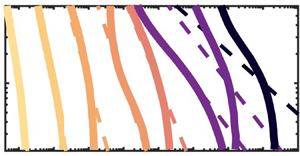Article contents
Transport of inertial particles in high-Reynolds-number turbulent boundary layers
Published online by Cambridge University Press: 22 September 2020
Abstract

We investigate the transport of size-selected particles suspended in turbulent boundary layers at friction Reynolds numbers up to  $Re_\tau = 19\,000$. We use microscopic glass spheres in air, spanning a wide range of viscous Stokes numbers,
$Re_\tau = 19\,000$. We use microscopic glass spheres in air, spanning a wide range of viscous Stokes numbers,  $St^+ = 18\text {--}870$. These are imaged simultaneously with the flow tracers, and particle image and tracking velocimetry are used to measure the two-phase flow along a wall-normal plane in the logarithmic region. The air flow statistics are not altered by the particles at the present mass loading. In comparison to the classic equilibrium solution, the particle concentration profiles display weaker wall-normal gradients. This is shown to be an effect of particle inertia: this manifests itself through different mechanisms in different strata of the flow, and the effects on the concentration are captured by a three-layer parameterization of the profile. The particles lag the fluid across the boundary layer, with a mean slip velocity of the order of the friction velocity and increasing with particle inertia. Near the wall this lag is mainly due to the instantaneous slip of the particles relative to the surrounding fluid, while away from the wall the leading cause is the preferential sampling of low-speed fluid regions. Larger particles (in the size range of sand, as opposed to dust) display a qualitatively different behaviour, likely because of nonlinear drag effects. All considered particles oversample specific regions of the fluid flow: they favour regions of negative streamwise fluctuations, especially ejection events, and are likely to be found about the centre of strain cells with backward-leaning compressive axis and forward-leaning extensive axis. This pattern is visible for a wide range of Stokes numbers, underscoring the multi-scale nature of preferential concentration. The present findings highlight how high-Reynolds-number features of turbulent boundary layers impact the transport of suspended inertial particles, and thus are especially relevant to environmental and geophysical flows.
$St^+ = 18\text {--}870$. These are imaged simultaneously with the flow tracers, and particle image and tracking velocimetry are used to measure the two-phase flow along a wall-normal plane in the logarithmic region. The air flow statistics are not altered by the particles at the present mass loading. In comparison to the classic equilibrium solution, the particle concentration profiles display weaker wall-normal gradients. This is shown to be an effect of particle inertia: this manifests itself through different mechanisms in different strata of the flow, and the effects on the concentration are captured by a three-layer parameterization of the profile. The particles lag the fluid across the boundary layer, with a mean slip velocity of the order of the friction velocity and increasing with particle inertia. Near the wall this lag is mainly due to the instantaneous slip of the particles relative to the surrounding fluid, while away from the wall the leading cause is the preferential sampling of low-speed fluid regions. Larger particles (in the size range of sand, as opposed to dust) display a qualitatively different behaviour, likely because of nonlinear drag effects. All considered particles oversample specific regions of the fluid flow: they favour regions of negative streamwise fluctuations, especially ejection events, and are likely to be found about the centre of strain cells with backward-leaning compressive axis and forward-leaning extensive axis. This pattern is visible for a wide range of Stokes numbers, underscoring the multi-scale nature of preferential concentration. The present findings highlight how high-Reynolds-number features of turbulent boundary layers impact the transport of suspended inertial particles, and thus are especially relevant to environmental and geophysical flows.
- Type
- JFM Papers
- Information
- Copyright
- © The Author(s), 2020. Published by Cambridge University Press
Footnotes
Present address: Department of Mechanical and Process Engineering, ETH Zurich, Switzerland.
References
REFERENCES
- 29
- Cited by



